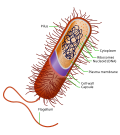The eukaryotes (/juːˈkærioʊts, -əts/ yoo-KARR-ee-ohts, -əts) constitute the domain of Eukaryota or Eukarya, organisms whose cells have a membrane-bound...
61 KB (6,102 words) - 11:22, 19 October 2024
Prokaryote (section Relationship to eukaryotes)
nuclei are placed in a third domain: Eukaryota. Prokaryotes evolved before eukaryotes, and lack nuclei, mitochondria, and most of the other distinct organelles...
44 KB (4,782 words) - 04:08, 8 November 2024
Amorphea (category Eukaryote unranked clades)
or to Malawimonada or being a paraphyletic group external to all other eukaryotes. The unikonts have a triple-gene fusion that is lacking in the bikonts...
9 KB (1,160 words) - 16:46, 18 June 2024
Eukaryogenesis (redirect from Crown eukaryotes)
eukaryotic cell and lineage, is a milestone in the evolution of life, since eukaryotes include all complex cells and almost all multicellular organisms. The...
19 KB (1,957 words) - 15:07, 20 June 2024
Eukaryote hybrid genomes result from interspecific hybridization, where closely related species mate and produce offspring with admixed genomes. The advent...
110 KB (11,196 words) - 05:23, 20 May 2024
cells do have a distinct nucleus (eukaryotes). In 1937 Édouard Chatton introduced the terms "prokaryote" and "eukaryote" to differentiate these organisms...
74 KB (4,819 words) - 10:10, 4 November 2024
Microorganism (section Eukaryotes)
adult form are eukaryotes, including humans. However, many eukaryotes are also microorganisms. Unlike bacteria and archaea, eukaryotes contain organelles...
74 KB (7,752 words) - 15:13, 30 October 2024
Plants are the eukaryotes that form the kingdom Plantae; they are predominantly photosynthetic. This means that they obtain their energy from sunlight...
95 KB (8,067 words) - 16:08, 5 November 2024
Archaea that contain eukaryotic signature proteins. It appears that the eukaryotes, the domain that contains the animals, plants, and fungi, emerged within...
33 KB (2,841 words) - 06:47, 4 November 2024
Protist (category Obsolete eukaryote taxa)
including extreme habitats. Their diversity, larger than for all other eukaryotes, has only been discovered in recent decades through the study of environmental...
99 KB (10,341 words) - 09:13, 10 November 2024









